Buede D.M. The Engineering Design of Systems Models and Methods
Подождите немного. Документ загружается.

Finally Yourdon [1989] recommends avoiding processes and stores that are
sinks and sources and label ing all flows and processes.
12.3.2 N-Squared (N
2
) Charts
Systems engineers [Laws, 1990b] created N
2
charts in the 1960s to depict the
data or items that are the inputs and outputs of the functions in the functional
architecture. The N
2
elements provide the same description of a hierarchical
decomposition of the system’s functions as does IDEF0 and data flow
diagrams. The N functions that are a partition of some higher level function
are displayed along a diagonal of the diagram with N rows and N columns (see
Figure 12.10). Each function is shown in a rectangle with a numerical box
across the top. In the off-diagonal elements are roundtangles (rectangles with
rounded corners) that contain the names of the items being sent from the box in
the associated row to the box in the associated column. The charts (sometimes
called interface diagrams) are called N
2
because the chart contains N
2
boxes to
show the flow of items within (or internal to) the N functions. Every item
that exits the first function and enters the second function is in the box to the
right of the first function and above the second function. Items exiting the
second function and entering the first function are shown to the left of
the second function and below the first function. In general, items flowing
from the ith function to the jth function are in the ith row and jth column.
Additional boxes along the top and down the right are added as an option to
show the flow of external items into and out of the set of N functions,
respectively. The N
2
charts provide the same information as IDEF0 and data
flow diagrams with the exception of stores in data flow diagrams and control
items in IDEF0. Ancestor diagrams are used to show the items being exchanged
between the system and its external systems. Branches and joins are not used;
rather, items are defined at the lowest level of decomposition relevant to a
particular diagram and are then repeated as often as necessary. See, for
example, the item ‘‘sensed malfunctions’’ in Figure 12.10.
As can be seen in the N
2
chart in Figure 12.10, the most obvious value of this
technique is the information concerning where there is no interaction betw een
functions. Systems engineers have used the N
2
chart to allocate function s to
components such that there is minimal interaction among the components; the
order of the functions is modified so that the interactions among the functions
are all grouped close to the diagonal.
12.4 BEHAVIOR MODELING
This section addresses mod eling techniques that are used to explore the
dynamics of the system: behavior diagrams, finite-state machines, statecharts,
control flow diagrams and Petri nets. These modeling techniques address
12.4 BEHAVIOR MODELING 383
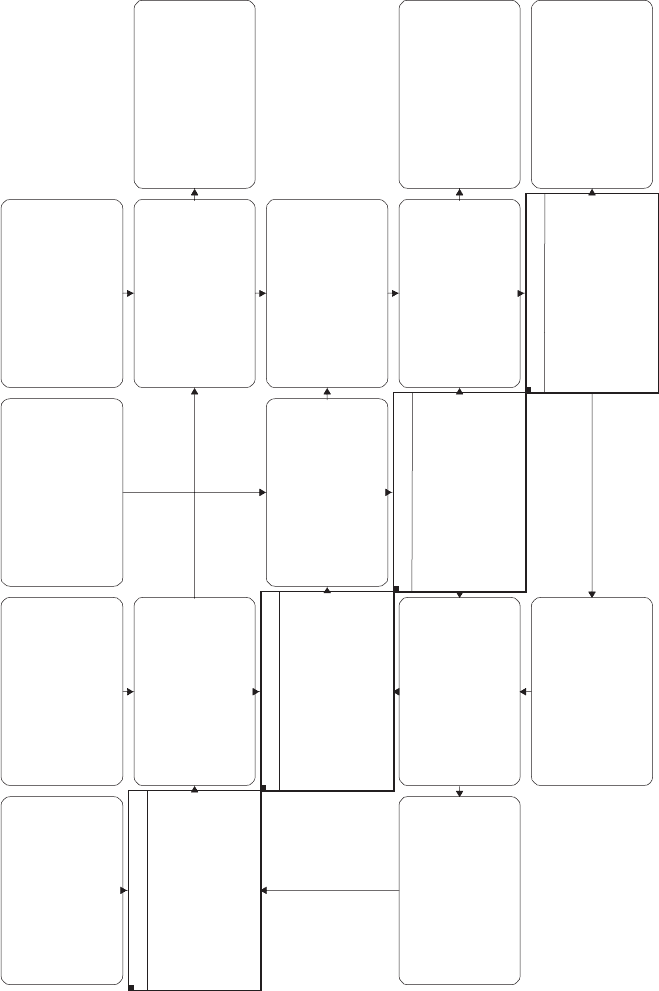
Request for Elevator Service
& Entry Support
Request for Emergency
Support
Request for Floor & Exit
Support
Modified Elevator
Configuration & Expected
Ussage Patterns
Electric Power & Emergency
Communication Response
Government Regulations
Passenger Characteristics
Structural Support, Alarm
Signals & Building
Environment
Government Regulations
Service, Tests & Repairs
Acknowledgment that
Request Was Received &
Status Information
Emergency Support
1.0
Accept Passenger Requests
& Provide Feedback
·Digitized Passenger
Requests
·Sensed Malfunctions
2.0
Control Elevator Cars
·Assignments for Elevator
Cars
·Sensed Malfunctions
Elevator Entry Opportunity
Elevator Exit Opportunity
Passenger Environment
·Elevator Position & Direction ·Elevator Position & Direction
3.0
Move Passengers Between
Floors
·Sensed Malfunctions
Diagnostic & Status
Messages
·Temporary Modification to
Elevator Configuration
4.0
Enable Effective Maintenance
& Servicing
FIGURE 12.10 An N
2
chart.
384
discrete-event behavior , which is behavior that is triggered by the occurrence of
specific events.
12.4.1 Behavior Diagrams
Behavior diagrams [Alford, 1977] originated as part of the Distributed
Computer Design System of the Department of Defense. System behavior is
described through a progressive hierarchical decomposition of a time sequence
of functions and their inputs and outputs. Functions are represented as verb
phrases inside boxes. There is a control structure represented by lines that flow
vertically, from top to bottom, through the boxes. The control structures (see
Figure 12.11) are identical to that described for FFBDs above. The control
lines have only one entry path into a function, but may have multiple-exit
control paths. Input and output items a re represented in boxe s with rounded
corners; their entry to and exit from functions is depicted by arcs that enter and
exit the boxes, respectively.
Specific control structures for sequence, selection, iteration, looping, con-
currency, and replication have been defined within behavior diagrams, just as
they have been in FFBDs. A sequence of functions is connected via a vertical
straight line. A selection function is denoted by a function with two or more
control lines emanating from the bottom of the function. The emanating control
lines must be labeled to denote the exit criterion associated with each control line.
The multiple control lines must also be joined lower in the diagram at a
select node, a small circle with a + inside. Figure 12.11 shows a selection
function on the top middle.
An iterate control structure is set off on a control line by two nodes. Each
node is a circle with an @* inside. There is an arc from the bottom iterate node
to the top iterate node with a DomainSet label that defines at what frequency or
how many times the fun ctions inside the iterate structure are to be exercised; see
the bottom left of Figure 12.11.
An exit loop control structure uses a selection function to determine the
point at which the repetition of a functi on (or set of functions) should be
terminated. The exit loop control structure is set off by two vertically placed
nodes (circles with an @ inside) that are connected with an arc going from the
bottom node to the top node. The selection function that is responsible for
ending the repetition has multiple exit control lines, one of which ends at an G
node or circle with G inside. An exit loop control structure is shown in the top
right of Figure 12.11. When the exit criterion for the G node is satisfied within
the function, control emanates out the control line with the G node and then
drops below the bottom iterate node to the L node.
The control structure denoting that functions can he executed concurrently
(see the bottom middle of Figure 12.11 and Figure 12.12) is depicted by two
vertically placed nodes designated by circles with & inside. In this special
control structure all of the control lines below the first concurrent node are
activated when control hits this first & node. The control line below the bottom
12.4 BEHAVIOR MODELING 385
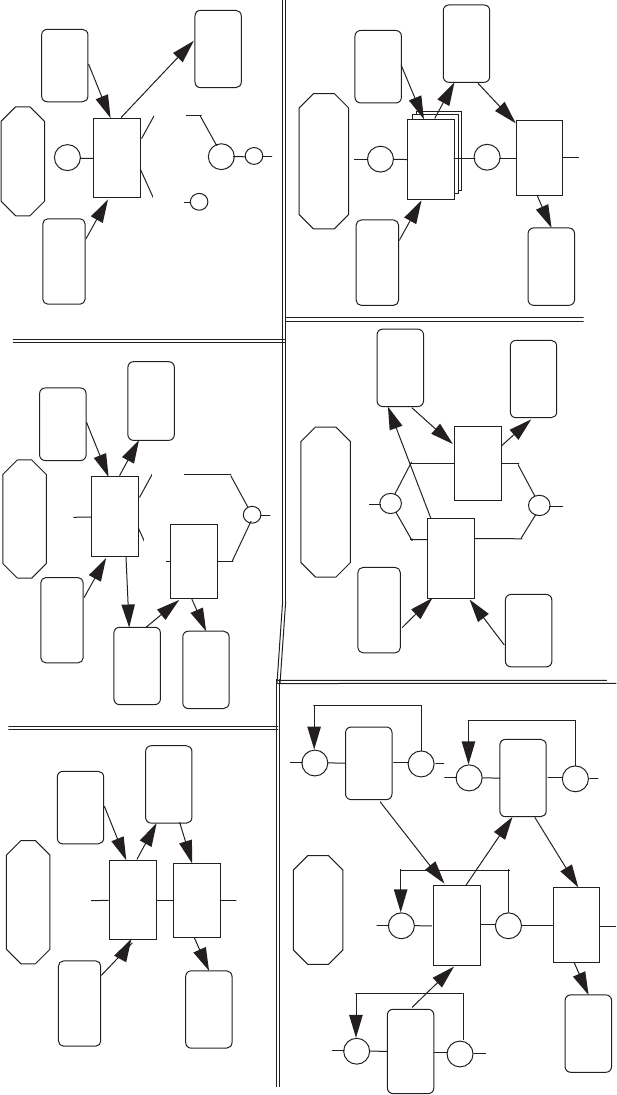
@
@
&*
&*
@*
@*
Update
Position
Update
Position
Update
Position
Detection
Data
Detection
Data
Detection
Data
Current
Track
Current
Track
Updated
Track
Updated
Track
Updated
Display
Updated
Display
Updated
Display
Updated
Display
Sequence
Update
Position
Update
Position
Update
Display
Update
Display
Update
Display
Updated
Track
Updated
Track
Updated
Track
Updated
Display
Updated
Display
Updated
Display
All tracks
@*
@*
All tracks
Current
Track
Current
Track
Current
Track
@*
@*
All tracks
Detection
Data
@*
@*
All detections
Iteration
Dropped
Track
Selection
+
Track Update
No Track
Update
Detection
Data
Detection
Data
Concurrency
&
&
Replication
Current
Track
Looping
L
Updated
Track
Remaining
Detections
G
Detections
Depleted
Update
Position
FIGURE 12.11 Control structures for behavior diagrams.
386
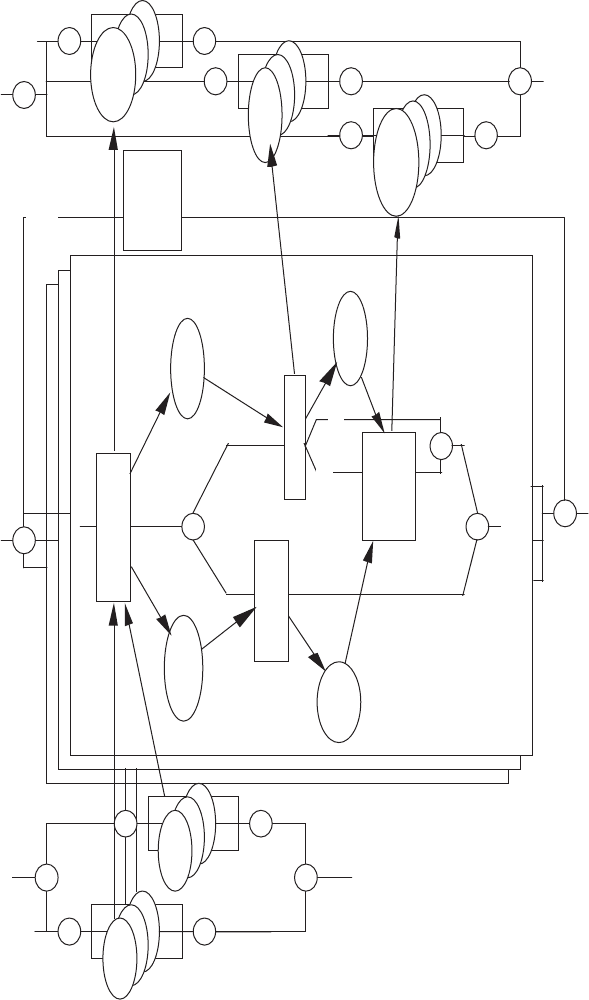
+
&*
Booster i
&*
+
&*
Booster i initial
track pattern
&*
&*
1.1. 1
Neutral
Object i
&*
&*
Processor
Control
With Coordination
Detect object
Track object
Track
pattern i
&
IR pattern i
&
Identify booster
+
&*
Nondetected
Object i
&*
+
&*
nonbooster i
&*
1.1. 2
1.1. 3
&*
initial
location i
Relay initial
booster track
pattern
+
booster
nonbooster
booster i
FIGURE 12.12 Concurrent control structure.
387
concurrent node cannot become active until all of the functions on the
concurrent control lines are finished executing.
Two vertically placed nodes with &* inside denote a replication control
structure, which is a special case of a concu rrent control structure. In this case
an identical function is executed concurrently, presumably by multiple copies of
the same resource. A DomainSet on a line that connects the upper and lower
replication nodes labels the number of concurrent resources. The fact that there
are multiple resources executing the same function is made visual by the symbol
for a ‘‘stack of papers’’ on the main control line between the upper and lower
replication nodes. There may be a Coordination function on the line with the
DomainSet label.
Definition of the items within the behavior diagram is equally important.
First, it is possible to use the sequence, concurrent, and replication control
structure to organize the items (or inputs and outputs) associated with
functions. Second, there are various categories of items. An item that enters
the system from outside or is produced by the system for outside consumption
is called an external item; all other items are called internal items. The
roundtangle for an external item is larger than that for an internal item. All
items can be hierarchical ly decomposed just as functions can. An item that is
decomposed is called a time item and is represented by a clear box with a solid
little square in the upper left corner. An item that is at the bottom of a
decomposition is called a discrete item; a discrete item is represented in a shaded
roundtangle. Discrete items are classified as either message, state, temporary, or
global items. A message item is sent from a function on one control line (or
process) to a function on a different control line (or process) and the message
item triggers the receiving function to execute as soon a s the function is enabled
by the control structure. Global items do not trigger the receiving function to
execute. State items are input to and output from functions on the same control
line and are therefore always internal items. A state item is not a trigger.
Temporary items are for special purposes.
12.4.2 Finite-State Machines and State-Transition Diagrams
Machines, a modeling domain for dynamic systems, are partitioned into finite-
state and continuous. Fin ite-state machines (FSMs) [Denning et al., 1978] have
only discrete-valued inputs, outputs, and internal items. Continuous machines
allow continuous and discrete inputs, outputs, and internal items. Continuous
machines are sometimes called analog machines. When digital computers
became more popul ar than analog computers, FSMs became the major focus
of attention in engineering due to the finite-st ate nature of digital computers.
Even so continuous and discrete signals are usually handled very differently by
a digital computer. The continuous variable (e.g., speed or internal temperature
of the elevator car) is represented by a word that typically contains many more
bits than the variable has significant digits. On the other hand a digital variable
388 GRAPHICAL MODELING TECHNIQUES
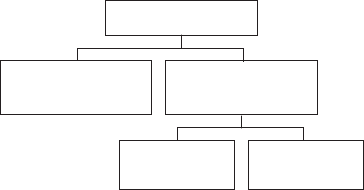
(e.g., operating mode such as fully operational or partially operational or not
operational, and direction of a specific elevator car such as up or down) is
usually represented by a symbolic word that has a relatively few number of
states, say less than 10.
Finite-state machi nes are usually divided into sequential and combinational;
see the machine partition in Figure 12.13. The focus here is on the sequential
FSM, as represented by a state-transition diagram (STD). A combinational
FSM is one in which its current outputs are characterized only by its current
inputs, a condition of having no memor y that is often not met. The sequential
FSM allow s past inputs to play a role in the determination of the current
outputs, thus enabling the FSM to have a memory. There is a formal
mathematical theory for an FSM, providing some interesting theoretical results
and simulation capability.
The STD models the event-based, time-dependent behavior of a system.
Recall from Chapter 7, the state of a system is defined to be its status, as defined
by as many variables as needed to determine the system’s ability to meet its
missions. The mode of a system is its operating condition, such as off, idling, or
moving for an automobile. It is the mode of a system that should be modeled by
an STD. However, as shown in Figures 12.14 and 12.15, there is a fine line
between the modes of a system and the functions of a system.
Boxes (or ovals) and arcs are the syntac tical elements of STDs; the boxes
represent system modes and the arcs represent the direction of mode change.
Typically the arcs are labeled to show both the input sti mulus (or event that
triggers the mode change) and the action or output taken by the system in
response to the event. The event and output are typically separated by a slash or
horizontal line: event/output. Figure 12.14 shows a partially comp leted STD
for an automatic teller machine. This STD is incomplete because the transitions
to the four customer choices are not labeled; the transitions from the four
customer choices are not depicted via arcs. It is possible that each might be
completed successfully or canceled. The withdrawal might be denied. In each
case the customer can choose another transaction or not. Figure 12.15 shows an
STD for an elevator car (this figure is a modification of one found in Gomaa
[1993]).
Continuous or
Analog Machines
Combinational
FSM
Sequential
FSM
Finite State
Machines (FSMs)
Machines
FIGURE 12.13 Partition of machines.
12.4 BEHAVIOR MODELING 389
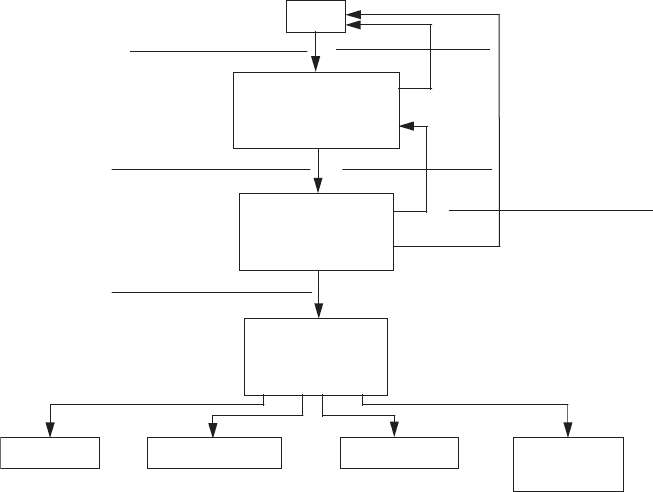
It is important to note diff erences between the view provided by an STD and
the view provided by one of the process models (DFD, IDEF0). The STD
makes no attempt to provide a functional partition of the top -level system
function or any function that is part of its partition. Rather the STD focuses on
key triggering events that will cause the system to transition from one
operational mode to another and identify any key system outputs produced
as a result that transition. Similarly process models are not required to capture
the system’s operating modes. In Chapter 7 the functional architecture was
defined to capture the system’s operating modes as the initial decomposition of
the system’s functions.
12.4.3 Statecharts
Statecharts are a generalization of higraphs by Harel [1987] to extend the
notions of STDs. This generalization of an STD is based on fonnal mathema-
tical principles and leads to theoretical results and simulation models.
A major criticism of STDs has always been that the entire diagram must he
contained on one level, meaning that an STD for a large system quickly
becomes unintelligible and unmanageable. Statecharts, by exploiting the subset
IDLE
WAITING FOR
CUSTOMER
IDENTIFICATION
WAITING FOR
CUSTOMER’S
ACCESS CODE
WAITING FOR
CUSTOMER’S
CHOICE
DEPOSIT
WITHDRAWAL
TRANSFER
ACCOUNT
BALANCE
Cust. ID Presented
Process ID for Validity
Cust. ID Read
CN:‘‘Enter Access Code’’
Access Code Validated
CN:‘‘Main Menu Choices”
Invalid Access Code
CN:‘‘Please Re-enter’’
3rd Invalid Access Code
CN:‘‘Transaction Terminated’’
Unread Cust. ID
CN:‘‘ID Unreadable’’
FIGURE 12.14 State-transition diagram for an ATM.
390
GRAPHICAL MODELING TECHNIQUES
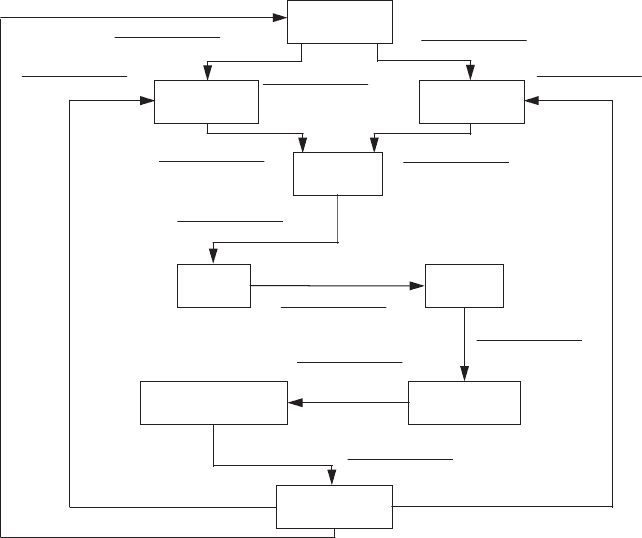
properties of higraphs, provide a means to develop hierarchical STDs. The
atomic blobs in a statechart are singleton, or atomic, states.
Figure 12.16 presents an external system representation of a cruise control
system (CCS) [Charbonneau, 1996]; the human operator and the remaining
components in the car are the external systems. Noting how the action ‘‘b’’ and
‘‘b hat’’ affect all three subsystems by causing simultaneous state transitions
with a single event demonstrates an extension by statecharts over the STD. The
states to which the X label is connected indicate the initial condition or state for
the three systems. Note that inside state ON for the automobile are the states of
acceleration, deceleration, and maintain speed.
Arcs in statecharts are label ed, just as they in STDs. Inside the system the
initial state is identified by finding the arc that emanates from a black dot; the
state that this arc enters is the initial state of the system; see Figure 12.17.
Figure 12.17 presents the decomposition of the NOT OFF state of the CCS.
The OFF state was not decomposed. Recall from the discussion on higraphs
that the vertical dotted line ind icates a Cartesian product. The INDICATOR
and the SYSTEM STATUS blobs are independent, defining a Cartesian
product. Both INDICATOR and SYSTEM STATUS have two states. The
state DEAD for the IND ICATOR is not decomposed.
Elevator Idle,
Door Open
Preparing To
Move Down
Preparing To
Move Up
Elevator
Door Opening
Elevator
Enabling Entry/Exit
Elevator
Moving
Elevator
Stopping
Elevator
Starting
Checking Next
Destination
Down Request
Close Door
Close Door
Up Request
Door Closed
Up Indicator
Door Closed
Down Indicator
Acceleration > 0
Departed Floor
Near Requested Floor
Slowing
Door Opened
Direction Indicator
Elevator Stopped
Door Activated
Pause Timer Elapsed
Destination Query
Up Request
Close Door
Down Request
Close Door
No Request
Maintain Open Door
FIGURE 12.15 State-transition diagram for an elevator car.
12.4 BEHAVIOR MODELING 391
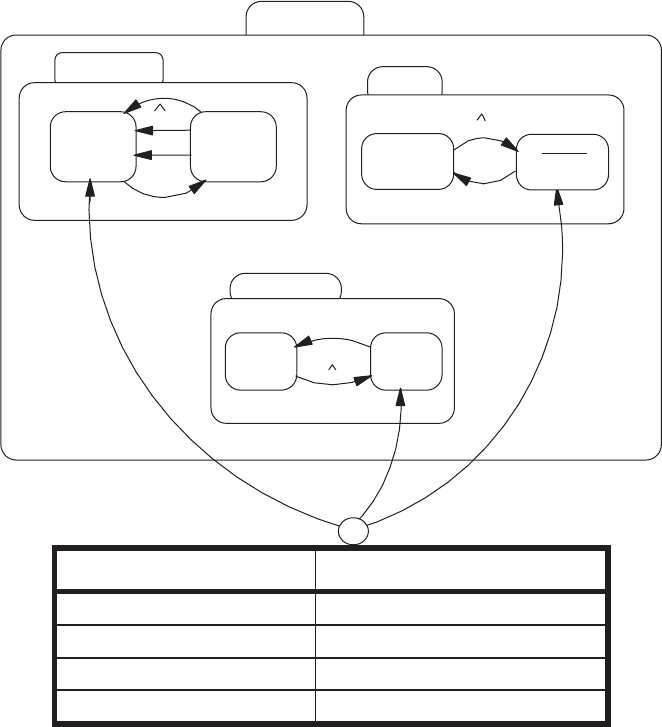
The ability to rep resent unordered n-tuples in higraphs en ables statecharts to
depict states as being the orthogonal composition of elements from sets of
states. When the initial state is an n-tuple, there must be n initiating arcs to
define which element of the set of n-tuples is the initial state. Similarly, when
there is a transition from (to) a state that is part of an n-tuple to (from) one that
is not, the arc mu st be joined by an arc from (must branch to) n 1 other arcs
from other elements of the n-tuple.
Figure 12.18 shows the three states for ALIVE in Figure 12.17 that are
associated with the INDICATOR. The ‘‘w’’ activity in this third-level chart is
the same ‘‘w’’ in the supersystem top-level chart. This single activity, ‘‘w,’’
SUPERSYSTEM
HUMAN
AUTOMOBILE
b
b
CCS
w
OFF
w( b)
b
m
X
NOT OFF
b
b
DRIVE
DRIVE
ON OFF
ARC LABEL DEFINITION
b turn on car
b hat turn off car
m
w depress on/off button
accident occurs
FIGURE 12.16 External system statechart for a cruise control system (after
Charbonneau [1996]).
392
GRAPHICAL MODELING TECHNIQUES
